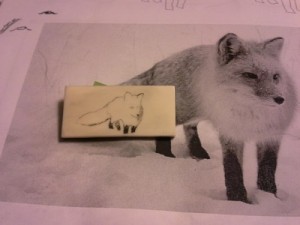 Alternative Ivory is a cast polyester plastic made to look and feel like real ivory. It is one of several alternatives that work well for smaller items like cabochons, earrings, and smaller knives.
Alternative Ivory is a cast polyester plastic made to look and feel like real ivory. It is one of several alternatives that work well for smaller items like cabochons, earrings, and smaller knives.
Polyester is often used for casting. A clear liquid, it takes pigments well and you can make either transparent, translucent or opaque castings depending on the additives you use. It turns solid once you add a curing agent (a polymerization catalyst) at room temperature under normal pressure. Polyester resin has the drawback of shrinking considerably during curing, making it unsuitable for intricate direct casts. Alternative ivory is created in sheets ranging from 1/8” to 3/8” as well as bars and rods. With the addition of coloring agents makes it opaque. A grain is created by mixing darker browns along with the lighter cream color which mimics ivory quite well.
We purchased some 1/8” sheets of alternative ivory from Masecraft to experiment with. In small pieces (about the size of a piano key head) the pieces are stiff and have the characteristic sweet smell of polyester when cutting. Anyone who drilled bowling balls in their youth found the plastic balls a welcome relief from the hard black rubber balls. It cuts quite easily, and makes it an excellent choice for starting out. It sands quickly and scrims easily as well, though you will want to use very sharp tools: dull tools will not incise alternative ivory but will instead create “hills and valleys” (for lines) and “peaks and craters” (for stippling). Doing fine work will take a subtle hand, but for bolder lines and less detail it can be a good choice.
[illustrations of hills and valleys/peaks and craters]
As the material is softer than ivory, detailed work may not stand up to the normal wear and tear it would be subject to as a normally used knife handle. We’d recommend using it for light duty knives where you don’t carry your keys or loose change in your pocket, or use it as a showpiece. Perfect for a “gentleman’s knife” where you’d be carrying it in your suit jacket pocket, the material would also work well for jewelry such as necklaces, earrings, brooches, tie-tacks, etc.
Any tools that you would use to cut wood will easily cut through this material. Scrimming tools will need to be sharp.
Shaping is very easy and polishing occurs quickly on this material. You can use an automotive lens restoration kit to bring a smooth shine very quickly.
India ink will wipe away easily on a polished piece but will stain if it is not polished smooth.
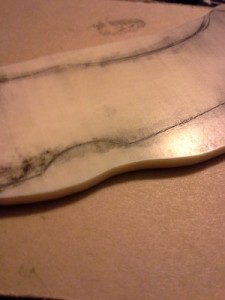
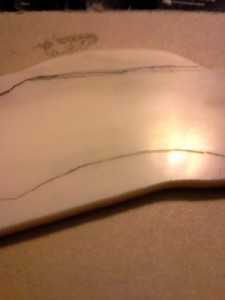
As mentioned before, hills and valleys will occur if you are using dull tools and press too hard, as will peaks and craters if you are doing stippling. Very little pressure is needed to scribe this material.
TIP:
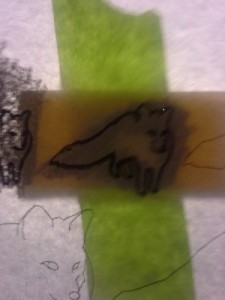
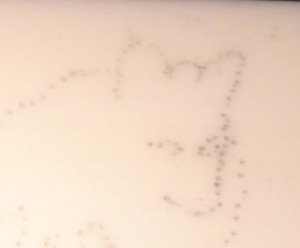
As we were creating this article we found a very good way to make micro-indentations when you are doing the “dot-to-dot” technique:
1) Choose your illustration and scribble on the BACK of it where you want your dots to appear.
2) tape your material to the underside of the illustration facing the polished side against the area scribbled with the aquarelle pencil.
3)Press the point of your scribe along the major lines to create the “stipples” (dots). You only have to press hard enough to make an indentation, you don’t need to pierce the paper.
4) Once finished, carefully remove the tape and your indentations will have the dots pre-filled for easier viewing.
This has two advantages: you don’t have to press as hard, and you can see the impressions much easier.
You can find Alternative ivory at Masecraft Supply in sheets from 1/8” to 3/8” as well as bars and rods. They have a $50 minimum order. Other places that have alternative ivory include Jantz Supply, Texas Knife Supply.
For smaller pieces and light duty knife handles as well as beginners alternative ivory will work well. It sands and carves so easily it’s an excellent choice for beginners and quick mock-ups, as well as making light duty knife handles and smaller jewelry pieces.